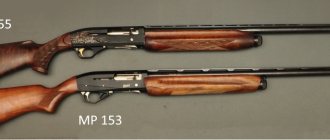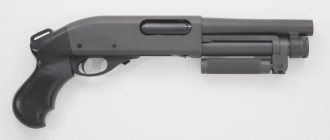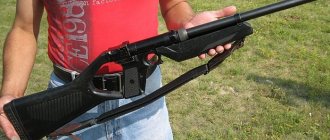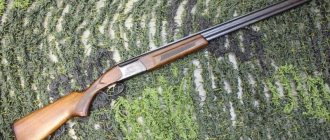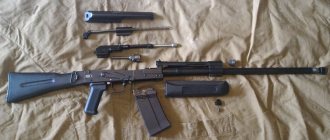In the second half of the 19th century in Izhevsk, specially hired craftsmen studied hunting rifle systems from all over the world. This is how the Izhevsk Arms Factory appeared. By 1902, the company already offered many different systems and calibers of rifles, carbines and shotguns. The Russian army placed single orders to reward the leadership with valuable models with artistic and commemorative engravings.
After the Civil War, there was practically no production of smooth-bore weapons. Hunters used old models or were left without the opportunity to catch birds. At that time, hunting was carried out not for entertainment, but for food or earnings. In 1924, to meet the demand of hunting cooperatives, the Izhevsk Arms Plant produces IZH-5 based on the American Iver-Johnson system. To speed up shooting, attempts were made to create double-barreled guns and add a magazine loading system, but due to the complexity of the design, increased weight and the low popularity of multi-shot and double-barreled models among hunters, the IZH-5 was then produced exclusively as a single-barreled gun.
The single-barrel gun was produced in calibers from 16 to 28. In the period from 1932 to 1941, the Tula Arms Plant produced versions of 16 and 20 calibers. At the same intervals, mass production was organized at the Zlatoust arms factory. The Great Patriotic War made its own adjustments in the period from 1941 to 1945. In 1949, the production of single-barreled IZH-5 hunting rifles was discontinued throughout the country. After the war, IZH-5 was produced only in Izhevsk, and in 1949 production was curtailed forever. There are samples online with marks supposedly from the late 50s, but due to the poor condition of the metal, it is impossible to confidently read the numbers and say that this is exactly 5 and not 3.
Description
IZH-5 is the result of a modification of the American Iver-Johnson rifle. The use of civilian weapons as a role model made it possible to do without a massive bolt, which necessarily remains in the design after converting a military rifled weapon into a hunting smoothbore weapon. The use of a massive bolt is due to the high pressure generated when firing combat rifled weapons. Hunting smoothbore cartridges create significantly less pressure, which reduces the weight of the weapon. Other advantages of the American system are a spent cartridge ejector, a reliable and convenient barrel bore locking system, high accuracy and accuracy, relative simplicity of design and high reliability of the weapon as a whole. Due to the combination of characteristics, the Iver-Johnson system was copied and modified not only in the Soviet Union, but throughout the world. According to rumors, competent hunters in the USSR gave the remake of the American model the sarcastic name “Izhevsk-Johnson” due to the strong similarity of the trigger mechanism and the complete identity of the barrel locking system.
Historical reference
In the second half of the 19th century in Izhevsk, specially hired craftsmen studied hunting rifle systems from all over the world. This is how the Izhevsk Arms Factory appeared. By 1902, the company already offered many different systems and calibers of rifles, carbines and shotguns. The Russian army placed single orders to reward the leadership with valuable models with artistic and commemorative engravings.
After the Civil War, there was practically no production of smooth-bore weapons. Hunters used old models or were left without the opportunity to catch birds. At that time, hunting was carried out not for entertainment, but for food or earnings. In 1924, to meet the demand of hunting cooperatives, the Izhevsk Arms Plant produces IZH-5 based on the American Iver-Johnson system. To speed up shooting, attempts were made to create double-barreled guns and add a magazine loading system, but due to the complexity of the design, increased weight and the low popularity of multi-shot and double-barreled models among hunters, the IZH-5 was then produced exclusively as a single-barreled gun.
The IZH-5 model is actually the first serial single-barrel gun from the Izhevsk plant since the 1920s; its development began back in 1924. The beginning of mass production dates back to June 1927, and it was produced intermittently until the 1950s.
The location of the trigger in the middle of the block differs significantly from ordinary breech-loading single-barreled guns with a traditional trigger on the side plate. In everyday life, this placement in the trigger block is often called the middle one.
The design of the IZH-5 single-barrel gun is reminiscent of the long-standing Champion single-shot trigger with a large extended block, manufactured by Iver Johnson's Arms & Cycle Works.
At the beginning of the 20th century, it was offered by many trading companies of the Russian Empire - for example, in Moscow A.A. Bitkova, in St. Petersburg I.I. Chizhova, in Tallinn R. Passupa.
But it is not the only single-barrel trigger with such a block on our market; let’s name a similar trigger from Hopkins & Allen, which was imported to us in the 1910s. Our single-barrel IZH-5 is equipped with a large block of the same shape, but more streamlined.
According to the design, the IZH-5 single-shot trigger turned out to be a relatively heavy single-shot hunting weapon.
The main task in its creation was to achieve good performance in single-shot shotgun combat, which was ensured by a massive barrel and a large block. That is why, in fact, there is a similarity with the similar Iver Johnson Champion model.
The single-barrel gun was produced in calibers from 16 to 28. In the period from 1932 to 1941, the Tula Arms Plant produced versions of 16 and 20 calibers. At the same intervals, mass production was organized at the Zlatoust arms factory. The Great Patriotic War made its own adjustments in the period from 1941 to 1945. In 1949, the production of single-barreled IZH-5 hunting rifles was discontinued throughout the country. After the war, IZH-5 was produced only in Izhevsk, and in 1949 production was curtailed forever. There are samples online with marks supposedly from the late 50s, but due to the poor condition of the metal, it is impossible to confidently read the numbers and say that this is exactly 5 and not 3.
The IZH-5 smoothbore hunting shotgun was produced at the Izhevsk Arms Plant, in the workshops of the steel plant (1924-1941 and 1945-1948), and in Tula (1932-1941).
Design
IZH 5 is a single-barreled shotgun with an external hammer and a break-type barrel. The pistol-shaped stock with a butt and a steel butt plate was made of birch. There are belt swivels for easy carrying.
Partial disassembly and design of IZH 5
Partial disassembly is carried out by removing the forend and separating the barrel from the block by. The handguard is removed vertically downwards. In early versions, the entire barrel was removed; in the post-war period, the design was improved by adding a locking latch connecting the fore-end and the barrel. Locking is done by aligning the lever with the frame and the hook groove located under the barrel. The trigger mechanism uses a return firing pin and hammer, which are manufactured separately. When the trigger is pressed, the hammer is released and strikes the firing pin under the influence of a 160 mm mainspring, which leads to an impact on the primer and its ignition. The firing pin returns to its original position immediately after the shot under spring pressure. It is bolted to the block. Later modifications have a cover with dimensions of about 50x20 mm, which covers the rear shoe edge. The trigger axis was located in the same cover. The sights are limited by a slot for the rear sight in the block.
IZH 5 after restoration
Analogs
The gun in question was replaced by several modifications. Now a single-shot IZH-18 is being produced, which is manufactured in all standard calibers (from 12 to 32). The barrel is not equipped with an aiming rib; the chamber length is 70 centimeters. The barrel and forend are removable. The IZH-18 smoothbore hunting shotgun is equipped with a stock made of beech, birch or walnut and a pistol or straight neck. It can be easily disassembled into three parts.
The IZH-5 shotgun, unlike the modern modification, was not equipped with a special unlocking lever. It serves to quickly open the shutter and is located below the block, behind the safety bracket. When it is raised, the trigger is synchronously switched to combat mode and the barrel is unlocked. In the improved model IZH-18E, the ejector is also activated. If a misfire occurs, the trigger can be re-cocked without opening the carbine by moving the lever from top to bottom.
Despite the fact that production ceased in 1950, the IZH-5 is still popular among hunters and connoisseurs of old weapons.
The IZH-5 hunting rifle with a chamber of 28, 26 or 24 calibers can be used for training beginners. The 20-gauge shotgun model is often chosen by women, due to the low weight of the gun and low recoil.
Weapons of this type are still actively used in the United States of America. The wide range of available hunting specimens is ensured by lenient gun laws and the Second Amendment to the Constitution. A plethora of modern rifles and shotguns would seem to supplant the 120-year-old system, but the demand for lightweight guns with high accuracy and accuracy allows American factories to maintain mass production of such systems.
Advantages and disadvantages
Advantages:
- Accuracy and accuracy;
- Reliability of the design.
The long barrel length ensures high accuracy when shooting both bullets and shot and buckshot. Thanks to the simplicity of the design, the gun is highly reliable and durable, and caring for it does not cause problems.
Flaws:
- Single-shot design;
- Small caliber;
- Barrel wobble.
Disadvantages include the lack of a second barrel and a small caliber. A single-barrel, single-shot design forces the weapon to be reloaded after each shot, while a second barrel or magazine loading system allows two or more shots to be fired with minimal time between them. The small caliber limits the range of applications due to its low power and range compared to 12 gauge. After 200-400 shots, a loose barrel usually appears, but getting rid of it is not too difficult.
IZH 5
Also, the disadvantages today include the difficulty of acquiring a sample in good condition. The minimum “age” of a gun is 70 years; most are stored for many years without conservation or proper care. But with some luck, you can find a sample that was stored under the necessary conditions in excellent condition not only of the barrel and box, but also of the stock and trigger mechanism. The rarest are 24-caliber shotguns with a barrel length of 740 mm. There are references online to individual samples with a 785mm barrel.
After purchasing and registering a gun, it is imperative to carry out a full inspection and maintenance. Long-term storage without care can lead to the barrel bursting after the first shot.
Specifications
In the technical passport, the single-barreled hunting rifle is described as an external trigger gun. Performance characteristics of IZH-5 look like this:
- The length of the barrel can vary between 680-760 mm, however, there is unconfirmed evidence of the presence of a barrel of 800 mm.
- The longer the barrel, the greater the weight of the weapon and is in the range of 2.5-3 kg.
- Caliber 16-28.
- Accuracy 4%.
- Cartridges with a paper sleeve are used.
- To fire a shot you need to apply a force of 3 kg.
Accuracy, although stated at 40%, when tested with a load of No. 3 shot and black powder, often approached 47%
For the cylindrical drill barrel of the 16-gauge hammer, “50a” steel was used. At the end there was a pressure - a muzzle constriction. The nominal value of the caliber did not always correspond to the actual value, so many hunters, without relying on the specified parameters, took measurements themselves.
Browning Auto-5 semi-automatic shotgun
John Moses Browning developed many small arms and proposed a number of technical solutions that are still very popular. In addition, a number of weapons by J.M. Browning rifles are still in service with various armies, and also continue to be used by riflemen. One such product still in use today is the Browning Auto-5 self-loading smoothbore shotgun. It was the first self-loading gun in the world that managed to reach mass production. At the end of the 19th century, armies and amateur shooters were mastering new repeating rifles with manual reloading, and automatic systems were just taking their first steps. However, this did not stop designers from trying to create completely new class systems. In the creation of self-loading smoothbore shotguns, J.M. became a pioneer. Browning. He created the first version of the new project at the very end of the century.
Work on promising topics began in 1898, and soon Browning prepared design documentation for a new model. Soon he assembled a prototype gun and tested it in practice. Over the next few years, two more versions of the project appeared, which were also tested using prototype guns. The three versions of the weapon would use smokeless powder rifle cartridges and operate by recoiling a long-stroke barrel, but there were noticeable differences in the design of these examples.
General view of a late-release Browning Auto-5 shotgun from FN. Photo: Wikimedia Commons
Based on the test results of three experimental guns, the designer settled on the latest version. It differed from its predecessors in its high characteristics and more successful design. It was decided to bring it to mass production. After a short period of improvement, the self-loading rifle project was completed and offered to a potential manufacturer. In addition, the designer filed a number of applications for registration of inventions and received four patents.
A little later, after the start of mass production, the new gun received the symbol Browning Auto-5. This name reflected the possibility of automatic reloading, and the number indicated ready-to-use ammunition in the form of four rounds in the magazine and one in the chamber.
The new self-loading shotgun was developed using the experience of creating other systems with manual reloading. In particular, the overall layout was generally borrowed from other designs. It was proposed to attach the barrel and a tubular magazine on which the forend was located to the front of the receiver. A butt of the required shape was attached to the back of the box. This architecture of the gun, among other things, made it possible to subsequently carry out a number of upgrades affecting the ergonomics of the system without significant changes to the internal mechanics.
Belgian-made rifle and spare barrel. Photo: Icollector.com
The main part of the weapon, intended for mounting other mechanisms, was the receiver, made in the form of an assembly with a rectangular lower part and a rounded upper part. An inclined tube extended from the back wall of the box, which served as a housing for the return spring. In the front wall of the box there were holes for installing the barrel and magazine, and instead of the bottom it was proposed to mount the frame of the trigger mechanism and the magazine receiving device. On the right wall of the box there was a window for ejecting spent cartridges with a small spruce tree in the back.
The Browning Auto-5 shotgun had a smooth barrel with a length of 711 mm. A special lining was attached to the breech of the barrel for interaction with other weapon mechanisms. In the central part of the barrel there was a ring for contact with the return spring. The cylindrical return spring of the barrel, in turn, had to be put on the magazine body and located inside the forend. The barrel recoil system provided provisions for additional braking. A ring with a variable cross-section had to be in contact with the head of the return spring. The barrel ring, moving onto the conical part of the spring ring, was supposed to compress it and increase adhesion to the magazine body. Changing the design of the braking system made it possible to relatively quickly and easily adapt a self-loading gun for different ammunition.
Advertisement for the Auto-5 shotgun in a Russian catalogue, 1910. Photo: World.guns.ru
Under the barrel of J.M.'s new gun Browning placed a tubular magazine of simple design. It had a cylindrical body of the required diameter, on the front of which there was a thread for the lid. The supply of cartridges was to be carried out using a pusher and a coiled spring placed in the front of the magazine. The magazine was loaded through a window on the bottom of the gun, covered with a spring-loaded lid. A wooden forend with a U-shaped profile was attached to the gun on top of the magazine. Some Browning Auto-5 shotguns received a special lever on the left front of the receiver. When turning, it blocked the movement of cartridges from the magazine to the feeder, which made it possible to quickly change ammunition without fully and long-term loading of the magazine.
The bolt of the gun was made in the form of a metal block of complex shape. The contours of the bolt were designed so that it could fit tightly with the rear lining of the barrel. The bolt was also provided with means of coupling with the barrel in the form of a set of levers and a swinging cylinder. Inside the bolt there was a cylindrical channel for the firing pin and mainspring. With its rear part, the bolt had to be in contact with a return spring placed in a tubular casing. To cock the weapon, you had to use the bolt handle located on the right side of the gun.
The Auto-5 shotgun received a hammer-type firing mechanism. All the main units of this device were located in the lower rear part of the receiver. The design of the trigger ensured cocking of the course and its subsequent descent using a hook located on the lower part of the weapon. A movable safety button was placed at the rear of the trigger guard. With its help, it was possible to block the movement of trigger parts and thereby prevent an unwanted shot.
Shotgun diagram from the user manual. Figure Stevespages.com
The first project of J.M. Browning provided for equipping the gun with wooden fittings. A forend attached under the barrel and magazine, as well as a butt with a pistol lug, were used. It was proposed to make a channel of small diameter in the neck of the butt, which would go deep into the part. It should have housed the bolt return spring housing.
The basic version of the Auto-5 shotgun had a 12-gauge barrel (18.5 mm) and could use the appropriate cartridges for smooth-bore systems. Subsequently, weapon variants were created that were designed for other ammunition. Shotguns equipped with 16- and 20-gauge barrels were produced. The possibility of creating such modifications was due to successful automation, which could be adapted for the use of different cartridges with different characteristics.
Incomplete disassembly of the gun. Photo: Wikimedia Commons
The gun received the simplest sighting devices in the form of an open mechanical sight placed above the front of the receiver, and a front sight above the muzzle of the barrel.
With a barrel length of 711 mm, the basic version of the gun had a total length of 1270 mm and weighed 4.1 kg. Subsequent improvements to the design and alterations of various units repeatedly led to changes in dimensions and weight. Some modifications were shorter and lighter than the base gun, others were larger and heavier.
The operating principles of the automation of the new self-loading gun were quite simple. At the same time, the Browning Auto-5 project was a real breakthrough in the development and construction of small arms. The ideas contained in it were later repeatedly used to create new guns, both modifications of the Auto-5 and independent developments.
L23A1 shotgun used by the British Army. Photo World.guns.ru
Preparing the gun for shooting was quite simple. The magazine was loaded using a window with a spring-loaded lid on the lower surface of the receiver. Four cartridges had to be loaded sequentially into the magazine (in the basic 12-gauge configuration). After this, the mechanisms were cocked by pulling the bolt handle back and returning it back. By turning off the safety, you could start shooting.
Pressing the trigger activated the trigger, which hit the firing pin and fired the shot. Under the influence of recoil, the barrel, coupled to the bolt, had to move backward, compressing both return springs. Due to the specific design of the barrel recoil system, some absorption of the recoil impulse was carried out with a reduction in the speed of movement of the units. After traveling a distance equal to the length of the spent cartridge case, the automation uncoupled the bolt and barrel, after which the latter could return to the extreme forward position.
While moving the barrel forward, the spent cartridge case was removed from the chamber. After complete extraction, the cartridge case was thrown out through a window in the wall of the box. At the same time, the hammer was cocked and the firing pin was moved to the neutral position. Then the spring-loaded feeder had to push the new cartridge out of the magazine onto the chambering line. Under the action of its own return spring, the bolt had to move forward, push the cartridge into the chamber and re-engage with the barrel. After this, the gun was ready for a new shot.
A gun on a machine, designed for training shooters. Photo World.guns.ru
Initially J.M. Browning planned that the promising Auto-5 self-loading shotgun would be produced by Winchester, which had already produced many samples of its design. However, company executive T.J. Bennett refused to enter into a contract to produce the gun. This decision had two prerequisites of a marketing and economic nature. Winchester management doubted the prospects of the new weapon. In addition, for the first time in the history of collaboration, the designer refused to simply sell the project and demanded a percentage of sales of serial guns. All this did not suit the leaders of the arms company, which led to the termination of cooperation with J.M. Browning.
Next, the designer offered his development to Remington, but this time the contract was not concluded. The emergence of the agreement was prevented by the unexpected death of the head of the company and the subsequent change of management. J.M. Browning again had to look for a potential manufacturer of the world's first self-loading rifles.
In 1902, the gunsmith proposed a new system to the Belgian company Fabrique Nationale, which was already producing pistols of his design. Businessmen from Belgium became interested in the offer, which resulted in the emergence of a new contract and the further deployment of mass production. At the same time, an interesting story occurred that showed the error of judgment of T.J. Bennett. With his own money, J.M. Browning ordered a batch of 10 thousand new guns, which he sent to the USA. In about a year, all the guns were sold out, which showed the real prospects of self-loading weapons. Sales in Europe also revealed strong interest from shooters.
American made Remington Model 11 shotgun. Photo: Wikimedia Commons
In 1906, official Washington raised import duties on small arms, which had a significant impact on the market. Not wanting to lose a lucrative business, J.M. Browning and Fabrique Nationale decided to sell the license for the production of Auto-5 shotguns to the American company Remington. Shortly thereafter, new guns called the Browning Model 11 appeared on the United States market. Several minor details distinguished them from the basic system. In particular, American-made shotguns were not equipped with a system for blocking the supply of cartridges.
The main users of the new guns were hunters and sports shooters. The ability to fire multiple shots without the need for constant manual reloading has become a noticeable advantage over other guns of the same class. Such advantages often became a decisive factor in the purchase, capable of leveling out a noticeable difference in price.
In addition, self-loading rifles have attracted the attention of several armies. For example, during the interwar period, a significant number of Belgian-made Auto-5 shotguns were purchased by the British Army. After analyzing the experience of the First World War, in which some armies used “trench brooms,” the British military decided to strengthen infantry units with self-loading rifles. In the British Army, Browning Auto-5 shotguns were designated L23A1. During the Second World War, this weapon was actively used in various operations, primarily in the fight against Japanese troops in Southeast Asia. The guns remained in service after World War II.
Remington Mod.11 shotgun diagram. Figure Okiegunsmithshop.com
The method of using J.M.'s guns is interesting. Browning, used in US military aviation. The guns were mounted on special machines that imitated the machine gun mounts of bombers, which made it possible to carry out initial training of shooters. This approach made it possible to practice weapon aiming with significant savings in ammunition. A number of Auto-5 rifles have also been used in infantry service for a long time.
From time to time, both manufacturing companies modernized self-loading guns in order to improve performance, simplify operation, reduce the cost of production, etc. In addition, “Auto-5” variants were created, designed for new cartridges of other calibers. Like the basic system, new modifications attracted the attention of customers and were sold in large quantities.
According to available data, Browning Auto-5 family shotguns were produced by Fabrique Nationale and Remington for several decades, throughout almost the entire 20th century. During this time, more than two million guns of all variants and modifications were produced. Thus, Belgian gunsmiths, with constant modernizations, produced Browning Auto-5 shotguns until 1974, after which production was transferred under license to the Japanese company Miroku. Japanese licensed guns were produced until the late nineties. American production continued until 1967, and in the late forties the modernized Model 11-48 shotgun was released onto the market, featuring a lightweight design and the shape of various parts.
Markings on the gun. Photo Rockislandauction.com
Already at the very beginning of the last century, soon after the start of production, self-loading shotguns by J.M. Browning attracted the attention of potential buyers. In addition, over time, this development became of interest to other gunsmiths. As a result, several new guns entered the market, based on the Auto-5 mechanics, but produced by other companies. These or other copies or converted versions of J.M.'s gun. Brownings are still produced and have a certain distribution.
Back at the end of the 19th century, J.M. Browning managed to develop the world's first smoothbore shotgun with the ability to reload itself. This sample soon became the first representative of its class to be produced in series and put on the market. Finally, the Browning Auto-5 shotgun holds another record. This weapon was produced for almost 100 years without significant design changes: all changes concerned only individual parts and did not affect the automation. Thus, designer J.M. Browning managed to create a unique and outstanding weapon in every sense.
Based on materials from the sites: https://world.guns.ru/ https://browning.com/ https://remington.com/ https://stevespages.com/ https://all4shooters.com/ https:// militaryfactory.com/
